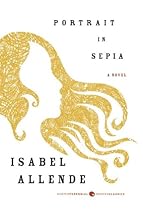
Overall rating:★★★★
Portrait in Sepia is the second book of the unusual trilogy that started with Daughter of Fortune and ends with House of Spirits. Aurora Del Valle decides to write her story and the experiences of the people around her. Aurora grew up with her paternal grandmother, Paulina Del Valle. The events take place between 1862 and 1910.
Paulina Del Valle was not the end-of-the-19th –century typical woman. She had a keen sense of business and made a deal with her husband to have her own bank account in England with the profit her business ventures brought. In a time when women depended completed of the closest male relative this was extraordinary.
Aurora grew up with this model of feminism. With time Aurora was able to become an avant garde woman herself. It is true that the beginning of the 20th century looked promising for women as some rules were relaxed, still it was not well accepted that a woman worked outside the house, had a trade, and even worse, had a lover while still married (divorce did not exist back then).
Portrait in Sepia starts in San Francisco, specifically in Chinatown. Isabel Allende, once more, makes a great job of describing the smells, people’s physical appearance in a way that immediately transported me to where the scene was taking place. From San Francisco, Aurora and Paulina traveled to Europe, and after Paulina’s husband death, back to Chile permanently. Once in Chile, Ms. Allende takes the reader somewhere south of Santiago (I suspect to the Puerto Montt area) where the landscape was generous and paradisiacal.
The connection to the next book, House of Spirits, is a subtle one. Rosa and Clara, Nivea and Severo’s daughters (two of the main characters in House of Spirits) are mentioned once in Portrait in Sepia. I remember when I read this passage the first time. I became a little dizzy with the realization that I was being taken back to where everything started.
This book is available in paperback..
Originality:★★★★
Beauty and use of language:★★★★
No comments:
Post a Comment